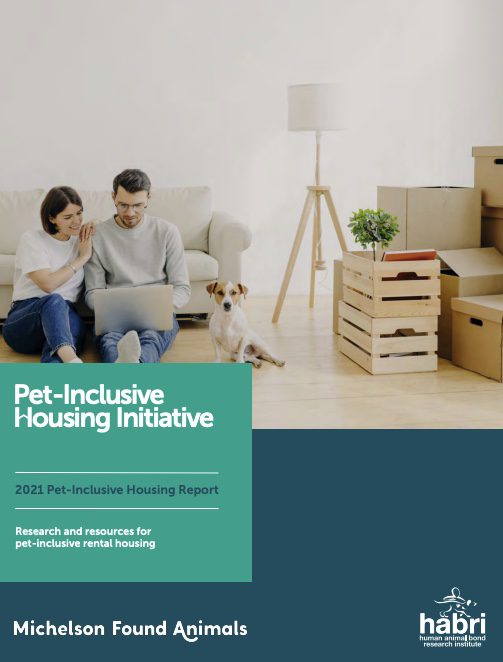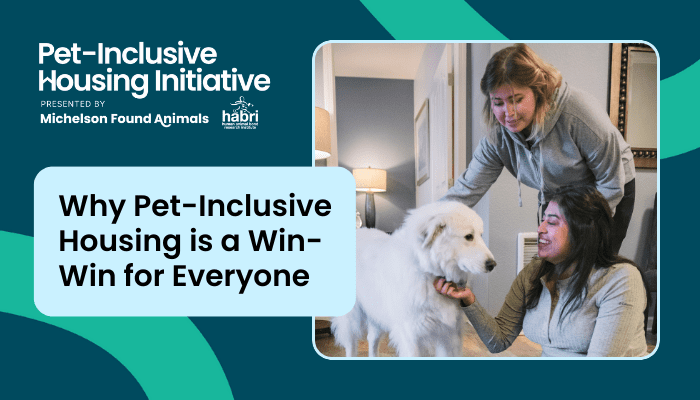The Industry-Changing Work of Judy Bellack
By Siobhan Brier
After working for 30 years in the multifamily industry, Judy Bellack felt it was time for a career shift.

“I reached a point where I had given so much of myself to corporate America, and when you throw yourself into something so heavily, it can take a toll over time,” she said. “I loved what I did, but I needed to call more of the shots in my own life. So I decided to step back and be my own boss.”
Judy started her own consulting business working with tech start-ups related to her industry. It wasn’t long before she was contacted by a connection to Michelson Found Animals (MFA).
The Beginnings of the Pet-Inclusive Housing Initiative
As a lifelong animal lover and mama to three pups (Sadie, Emma, and Koda pictured here), Judy had already noticed a widespread problem with apartment communities and housing developments when it came to housing people with pets.
“The first time I realized it was an issue was when my daughter was looking for an apartment,” Judy recalled. Her daughter had a gorgeous and kind pitbull of her own. “She was recently married, in her early 20s, looking for her first apartment, and no one would rent to them,” Judy said.
But when Judy was put in touch with MFA, she figured it might be time to make the switch from supporting animals through donations and volunteering to supporting them with her time and expertise.Judy was informed that MFA had recently created a new initiative focused on creating sustainable, pet-inclusive housing solutions in the housing industry. It was called the Pet-Inclusive Housing Initiative, or PIHI (pronounced “pie-high”). Judy says that when she heard about the need for someone with multifamily experience to join the team, she replied, “Are you for real? This sounds like the absolutely perfect thing for me.”
Why is it so hard to find pet-friendly housing?
The Pet-Inclusive Housing Report, created by MFA in partnership with the Human Animal Bond Research Institute (HABRI), found that “while a near-unanimous 93% of rental housing operators agree that pets are an important part of the family, 72% of rental housing residents say pet-friendly housing is hard to find.”
Interestingly, a whopping 76% of rental owners consider themselves “pet-friendly.” But if most rental owners claim to be open to accepting guests with pets, why is it that an overwhelming majority of residents say pet-friendly housing is difficult to find? In reality, according to the report, only 8% of rental housing is free of all pet restrictions. That means that the label “pet-friendly” doesn’t necessarily reflect a rental space’s ability to welcome pets of all kinds.
Judy’s Work with PIHI
Many of the obstacles that Judy notices in her work are related to the simple fact that the pet-inclusive housing problem just isn’t something many people are aware of, even though it’s an issue that affects a significant portion of the population.
“Most operators just haven’t thought about their pet policies in ten years,” Judy said, “so we come armed with a lot of data. Our goal is to have a conversation inside the building. We don’t want to be the outsiders banging the drum and screaming, ‘you need to do the right thing.’ We want to have a business conversation with them in terms that are meaningful for them.”
Dispelling Myths about Pet-Inclusive Housing
A key part of Judy’s mission is unpacking some of the barriers that often drive rental space owners to limit or ban pet ownership on their properties. PIHI’s work has uncovered data that contradicts many reasons landlords and property owners are hesitant to take on pet-friendly policies, including:
Myth: “My liability insurance won’t allow certain breeds.”
Reality: “There isn’t a lot of actuarial data to support breed limitations,” Judy said, arguing that commonly-cited fears of liability insurance failing to cover certain pet breeds are based on assumptions. Experts agree that breed-specific legislation does not enhance public safety, which has led many insurance companies to abandon breed restrictions.
Judy further pointed out that liability for a pet’s actions lies with the pet owner, “and sometimes property owners need to be reminded of that fact.”
Myth: “While most animals will probably be fine, there’s no way for me to know which will pose a safety risk.”
Reality: There are resources that can help property owners assess how much of a safety risk a pet may pose.
“There are now numerous screening services available, such as PetScreening” Judy pointed out. “You can determine any history of aggression as well as vaccine records, among other things.” She noted that while property owners may be liable for injuries “if they know a dog has been aggressive and they allow it on site,” simply making use of services like these means that evaluating pets on an individual basis rather than by breed or weight is not only possible but simple.
Myth: “Larger dogs, heavier dogs, and aggressive dog breeds are more dangerous.”
Reality: A common obstacle many pet owners face when seeking housing is strict restrictions on pet breed, size, and weight. These restrictions often stem from misconceptions about breed-specific behavioral concerns, like aggression. “Then you also hear people who say, ‘I don’t know, aren’t these breeds more dangerous?’ That’s when we just go back to the data,” Judy said.
“A recent study found that only 9% of a dog’s behavior is associated with its breed. It has more to do with the dog’s training and upbringing.”
Myth: “If I allow dogs, then there will be dog waste everywhere, and other residents will complain.”
Reality: “There are a lot of pet waste solutions now,” Judy said. “Installing waste stations with doggy bags and receptacles is a simple but effective solution. Most pet owners pick up after their dogs, especially if you make it easier for them.”
And for those pet owners who don’t pick up after their dogs? There’s a service called PooPrints that allows for DNA testing of waste. It works like this: all pet owners provide a DNA sample of their pet when they move in. You explain to the pet owners that the first time they leave dog waste, they get a warning, and the second time, they get fined. Then, if someone leaves dog waste, the waste is tested to determine whose pet it came from so you can talk to the resident.
Myth: “But pets are messy and destructive. If I allow pets, then I will have to pay for it when they damage the property.”
Reality:Many property owners are concerned about potential damage to their properties and the surrounding areas. Judy explained how minimal the risk of severe damage to a rental property by a pet truly is.
Fewer than 10% of pets are reported to cause any damage whatsoever to rental properties, and the average damages typically total around $210. That’s lower than most pet rental fees or security deposits.
Furthermore, just 2% of pets caused enough damage to warrant a security deposit deduction. The majority of pet owners pay out of pocket to fix any damages that may arise during their time renting.
Working with Apartment Complexes to Develop Plans for Allowing Pets
“We don’t advocate that anyone just lift their restrictions, and that’s it. We want it to happen thoughtfully and responsibly,” Judy explained.
“Have a plan. Think through your guidelines and policies and over-communicate these to residents. What services will you need to deploy? What will you require of residents with pets? Creating expectations – like always leashing dogs and picking up waste – is a critical component for success. If there is a violation, is there a fine? How many warnings does someone get? How will you market this? What is the communication with other residents? If there’s someone on site who is afraid of animals, how can you talk to them about that?”
Judy knows that the best way to create a solution that’s beneficial for both property owners and pet owners is by acknowledging the reality of changing policies. Ensuring that all residents are comfortable, safe, and able to meet their needs is a vital step toward long-term success.
Demonstrating the Benefits of Pet-Friendly Housing (and spreading the word)
Since beginning work with PIHI, Judy has developed multiple case studies that demonstrate the need for pet-inclusive housing as well as its benefits. So why, according to Judy, should property owners consider lifting restrictions and creating new, pet-inclusive policies?
Pet-Inclusive Housing Makes Economic Sense
A major perk of pet-inclusive housing, Judy claims, is its ability to attract residents who will stay longer.
“On average, residents in pet-friendly housing stay 21% longer than those in non-pet-friendly housing.” Though it may not seem huge, this figure translates to residents staying about 10 additional months. For an average 200-unit apartment community, this can add up to tens of thousands of dollars saved on turn costs and vacancy loss.
Likewise, according to data collected by PIHI, 83% of rental owners say pet-friendly vacancies are filled faster, and 79% say pet-friendly units are easier to fill. Pet-inclusive policies, therefore, can make it easier for property owners to find renters, and they also boost the likelihood of a renter sticking around. That can save property owners serious money, time, and effort.Right now, PIHI’s work points out, many rental owners are missing out on additional benefits of pet-inclusive policies. 11% of renters say they have an unapproved pet, which means management is unaware of many pets . . . which may be an obstacle when communicating policies and helping find a missing pet’s family. It may also be a key contributing factor to rising Emotional Support Animal (ESA) accommodation requests which create significant additional work for already-overburdened leasing staff. Around 2.5 million rental properties currently house pets that are not on record. That creates an enormous gap in an operator’s ability to set expectations with pet-owning residents. Lifting restrictions creates more transparency and greater accountability. So, if you’ve decided to lift restrictions and you want to allow more pets, market that policy shift. People are looking for pet-friendly apartments. Instead of mentioning at some point on your website that your building is pet-friendly, put it on the forefront and advertise it loud and proud.
Pet-Inclusive Housing Saves Lives
Aside from bringing in and saving money, pet-inclusive housing policies can make a real difference in the lives of the animals they impact. PIHI’s work shows that 33% of pet-owning residents say they would get another pet if restrictions on their rental housing were lifted. That means more forever homes for more animals. Similarly, PIHI has found that 35% of residents without pets would get a pet if restrictions were lifted. Over time, changes like these could mean that up to 8.2 million more animals could find homes in pet-inclusive rental housing. There are tangible consequences to limiting the ownership of pets, too, including separating pets from their family or putting renters in sticky situations. 14% of renters say they have surrendered their pet as a result of their housing situation, and among those, 22% said they surrendered their pet because they were afraid of being evicted.
Pet-Inclusive Housing Makes Residents Happier
It may seem silly to suggest that allowing more pets into rental properties could lead to happier and healthier communities, but research suggests otherwise.
“Studies have shown that positive interactions with pets lower heart rates and increase hormones correlated to well-being, including oxytocin and cortisol,” Judy said. “The simple act of petting a cat or dog has been shown to reduce blood pressure, lower cholesterol, and improve heart health.”
The perks don’t stop there, though. Among both pet owners and non-pet owners, 71% of rental residents, according to PIHI’s research, say that pets can help bring people together within a whole community. This finding supports the idea that pet ownership can contribute to resident satisfaction and retention, even for those who don’t have furry friends themselves. The value of this sort of community bond, Judy stated, is hard to beat. She pointed out that in the absence of pets, there isn’t necessarily much to bring neighbors together: “The Pew Research Center found that 57% of Americans said they only knew some of their neighbors. PIHI research shows that 73% of dog owners agreed that their pet brought them closer to their neighbors, and 49% of cat owners said the same.”
Pet ownership can be even more critical for residents living in mid-rise and high-rise housing. Just 24% of residents living in urban areas say they know “all or most of” their neighbors. And, when compared to residents in single-family homes or garden-style apartments, 14% more residents in urban housing said their pet brought them closer to their neighbors. But why does it matter that pets can bring neighbors together? Well, according to Judy, “operators are always looking for ways for people to connect, especially because people are more likely to stay in their apartment if they have friends where they live; it makes for a more healthy community. If residents have dogs, they get to know each other, differences are resolved more amicably, and the community is more tight-knit.”
Looking Forward: The Future of Pet-Inclusive Housing

The fight to bring pet-inclusive housing to the vast majority of communities surges on, and PIHI’s work has already made great strides. Fortunately, the future looks bright. A massive 42% of pet-owning residents in rental spaces are Gen-Z or Millennials, which means that over time, demand for pet-inclusive properties will continue to grow. As for PIHI’s work, things are far from over. “We’re always excited to keep pushing forward,” Judy said. She continued:
“We’re trying to produce as many blogs and case studies as possible to amplify the strides in pet inclusiveness. We are creating tools to help operators, such as a revenue calculator and a scorecard to better measure just how ‘pet-friendly’ a certain apartment community is. These tools are designed to live on our website and help operators understand how pet inclusive they may or may not be and identify areas for improvement. We also want to keep demonstrating why pets are good for business, both financially and in terms of building connected communities.”
In addition to creating resources to help educate property owners and pet owners alike, the PIHI team is dedicated to celebrating successes that have already taken shape. “For the second year in a row, we’ll be hosting the AIM Pet Awards in Huntington Beach, CA. It’s a wonderful platform for recognizing rental housing operators who have become more pet inclusive by lifting restrictions, innovative pet-centric marketing campaigns, involvement in pet-adoption events, and much more.” Partnering with local shelters, increasing transparency about limitations, and implementing more inclusive pet policies are just a few ways property operators have begun to make a difference.
As Judy says, “70% of households in the US have a pet. Go capture that.”




